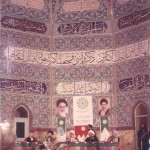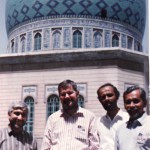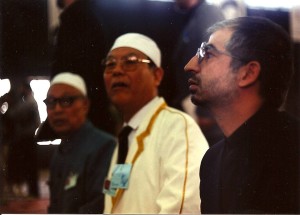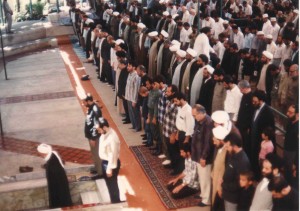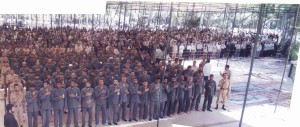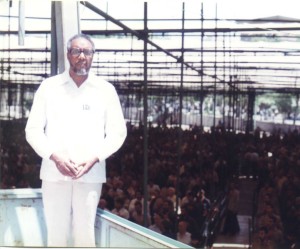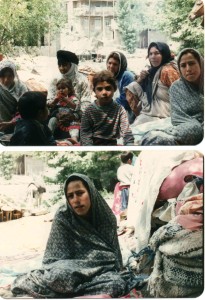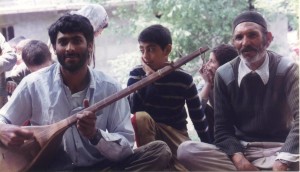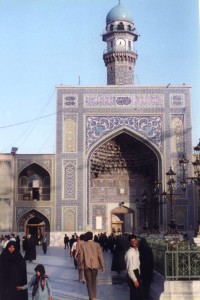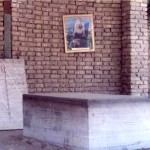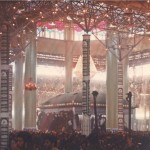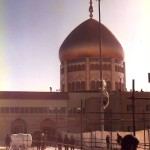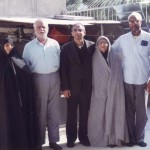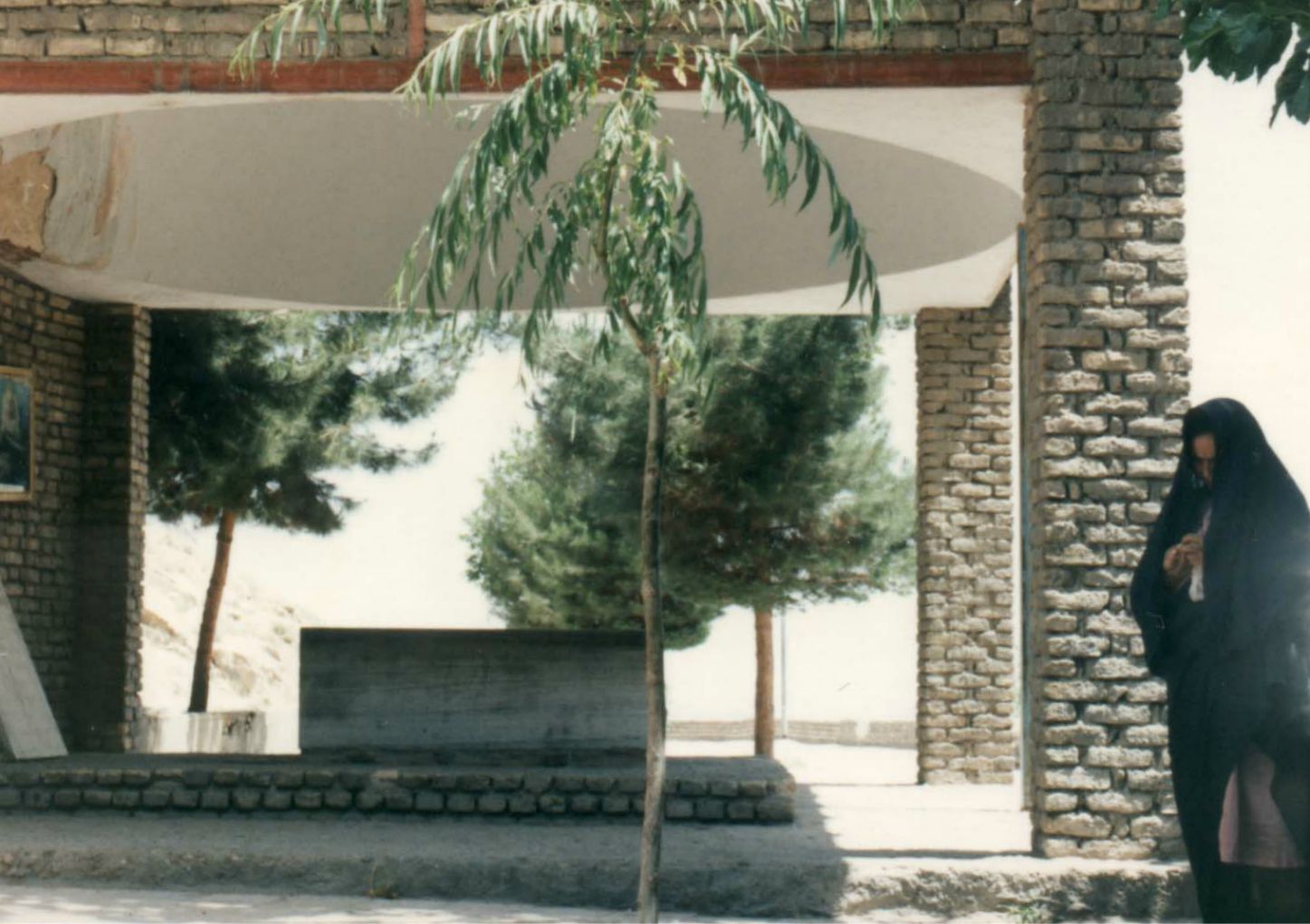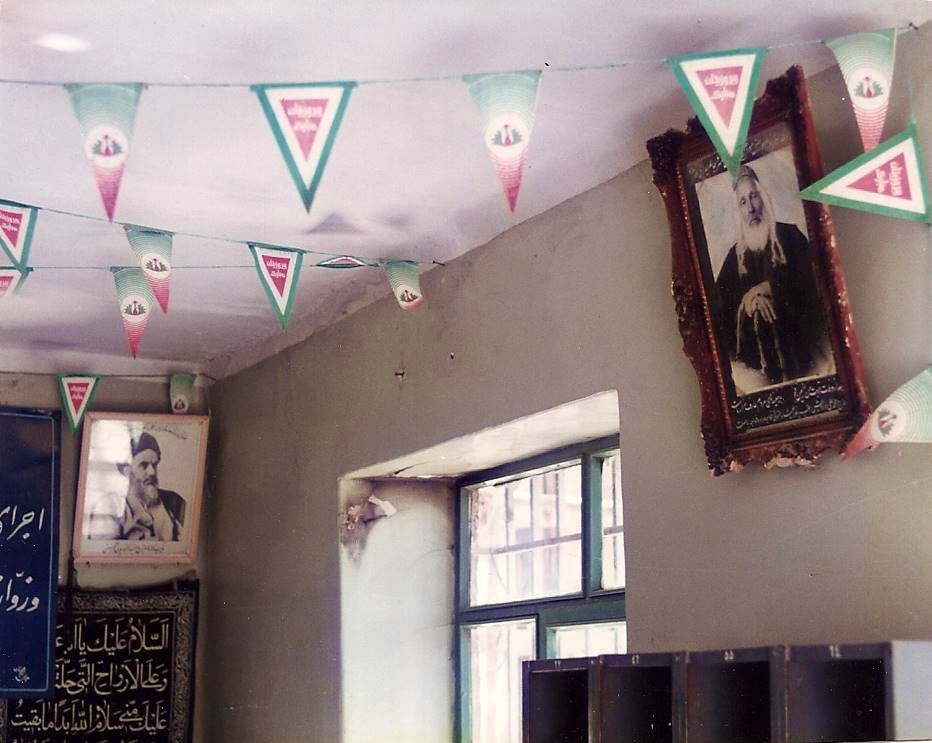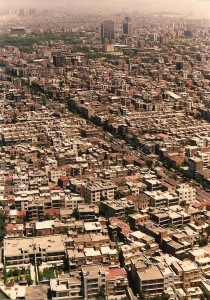Tears and Sweets – Reflections on a trip to Iran 1990
In May and June of 1990 I traveled to Iran to participate in the First World Conference on The Ahl-Al-Bait. (1) It was an unexpected invitation, but timely nonetheless, perhaps all the more auspicious because one of the chief regrets I had harbored for years was that I had not accepted an earlier invitation to travel to Iran during the early years of The Islamic Revolution. This earlier trip would have included a meeting with the revered Imam, and a tour of the Battlefront.
As an added incentive my original hosts invited me to bring my camera and my tape recorder to witness first hand the bloodshed and carnage that prevailed during the devastating war taking place between Iran and Iraq.
Unfortunately I was not able to go the first time. The second invitation came, as I mentioned earlier most unexpectedly – but this time I came prepared to document as much as possible. Many of these incidents and photo’s I will be sharing during the course of this look backward, at a time and a place that deserves a rewriting in the annals of Western history.
The Office of ‘Wilayat al Faqih’ I would suppose had been prompted by an idea that had sprung from the fertile imagination of the late Imam Khomeini to invite Muslim scholars, educators and clergymen from the various schools of Islamic thought to gather in one place to discuss the present condition of Islam and offer ideas on how to solve the many problems affecting the Ummah particularly the major social and political divisions between the so called Sunni and the Shiah. Many non-Muslims were in attendance also, drawn from academia and the world media.
Preceding the Conference by several weeks was a national celebration commemorating the demise of Imam Khomeini. The celebration took place exactly one year, to the day, of his death in 1989. By some wonderful set of circumstances I was invited to attend and participate in both.
As a guest of the Iranian Government I was accorded the freedom to indulge myself on many levels. I was able to attend and participate in the various Majlis’ and listen to the discourses of the great Ulama summoned from all parts of the world. Most of these Majlis’ was held at The Hussainiyah Irshad made popular in earlier years by the open series of lectures of Dr. Ali Shariati now available in print.
I also had the great fortune to visit a few of the historical cities like Qum, and Mashad, perform Ziyyarat at the major shrines. It was during these visits that I had the opportunity sit in the company of such a diversity of great spiritual beings the likes of the late Ayatollah Marashi Najafi, Ayatollah Haeri Shirazi, Sayyed Mujtaba Lari, and the controversial social and political warrior Askar Oladi. It might be useful and important to include the names of a few of the non-Iranian notables that I spent a lot of time with attempting to bring attention to the problems of our respective countries, Chief among them would be Sheikh Tijjan-Silla and Sheikh Haroon from Sierra Leone. Sheikh Muhammad Ali Zanzibari from Tanzania, Shaikh Bansi from Ghana and Samat Sayban from Sri Lanka.
I had occasion to sit in local parks and public places and talk to men and women from all walks of life: Bakers and blind men, scholars and rogues, former prostitutes and perhaps the most unexpected group of all to be able to visit with were the Iraqi prisoners of War who were allowed to attend the Salat al-Juma which is held each Friday at The University of Tehran.
The prisoners were grouped together in a special section adjacent to the front ranks but sectioned off by a tall wire fence. Many of them, to my surprise turned out to be black and brown indigenous Africans, many of them mercenaries conscripted from Libya, Egypt, Morocco and the Sudan – I was reminded of the old saying that: “Everyone has his Price”. But what I saw in their eyes confirmed that it is impossible for money to buy everything. It certainly can’t buy you dignity or forgiveness.
On several occasions I was given permission to speak to the prisoners and we chatted away, quite taken aback by the circumstances of our meeting. Many of them were surprised that I had come from America, and had time permitted I am certain that some even more amazing tales would be recounted. I did ask permission from my hosts if it would be possible to visit the prisoners at the prison they were being held, I had the undeniable feeling that some of them wanted to share their stories with me.
Permission was given – however time and circumstance did not permit. I had planned after a few visits to ask the Government to grant a few of these prisoners their freedom -remembering something I had read during my earlier studies of Islamic History about the special privileges accorded a guest in an Islamic country. I meant to test the waters of Iranian national civility as to the notion of forgiveness as espoused in our sacred books and traditions. Each time I requested something out of the ordinary I was usually told that they would look into it. Allahu Alim!
As for the equally unexpected conversations that I held with the film crews of the major television networks like NBC, CBS, and BBC who seemed to be pervasive at most state functions confirmed the open intent of our hosts. I found it amazing, to say the least, that on my return to the states that none of this important footage was seen by the American public.
Day after day for several weeks after my return to the United States the media continually reported the Commemoration ceremony and the Conference an absolute failure – the millions of people that I saw everyday filling the streets of Tehran, Mashad, and Qum -virtually flooding the area of the mammoth cemetery of Beheshti Zahra were for the most part unknown and nonexistent to the world outside Iran.
The overwhelming spectacle of millions of mourners in their ethnic and national variegations paying testimony to The Islamic Credo of: “Unity through Diversity”. Unfortunately these millions of mourner/pilgrims who gathered at what could easily be described at that moment in time as the center of the world came from all points of the planet earth were absent from the footage sent back to the states.
The newscasters in their typical over-abbreviated styles were sad to announce that no persons of worldly reputation or of any importance turned out – just a few old toothless stragglers who had nothing better to do than linger in the shadowy recesses of the empty streets begging for alms.
It was during this trip that I learned that the media can fool most of the people most of the time but they can’t fool all of the people all of time. In this case “Seeing was believing”. A lesson that many so-called Muslims living in the western world have yet to learn. The mainstream media informs you of what they want you to know. To quote a recent Editorial in the September 2004 issue of Crescent International entitled: Iraqi Olympians declare their support of resistance:
“It probably went down well among its target audience in the US -middle-class Middle Americans who know next to nothing about the real state of the world, dependent as they are on CNN and other such services for their information”.
During this visit we were jostled on occasion by the intermittent appearance of Dervishes and heads of state attempting to roam incognito, truck drivers vendors and hawkers of all manner of local merchandise. Several of my room mates and I had the opportunity to sneak away from the tight security and ride on the local bus system in Tehran.
We also sat and enjoyed wonderful varieties of foods and beverages in the open-air shops and were fascinated by the novelty of several restaurants that straddled the cold rushing streams of Darband. We Sampled the ice cold water that ran down from the from the Elburz Mountains in bristling streams that ran beneath the streets of Jamaron and also coursed their way through the Imperial Places of the Late Shah Muhammad Pahlavi.
My old friend and schoolmate from Houston now living in Iran, Daoud Ali – Muhammadi, about whom I shall mention again later, had the pleasure to have lunched and be entertained by a small band of Koli People (2) beside a quiet stream just south of The Museum of Firdausi at the outskirts of Mashad.
Days alone, meditating at the tombs of Imam Ridha (as), Imam Khomeini, & Allamah Tabatabai. Stirred by the pervading spirit of Mohammad Ali Darvish whose Barakat looms heavily around the tombs of Khaja Murad and Abba Saalt. (3)
Speaking of these whirlwinds of nostalgia that come and go – stories do undoubtedly bubble up like the dust devils of the desert places. The careless fisherman stands the chance of losing his catch if he fails to respond to the tug of the line or ignores the ripples that stir the surface.
I had an opportunity to at last visit the tomb of my beloved Imam Khomeini and be his guest alongside the tens of thousands of weeping, broken-hearted mourners. The sad bewildered countenance of endless scores of the silently bereaved – recently orphaned by the loss of the great father figure who had offered so much hope to an otherwise leaderless Ummat.
I visited his tomb at night alone under the full moon and in the day alongside the throngs – I saw the brilliant light emanating from his tomb and wondered and marveled, as many others as to whether the light came from above or below.
One particular incident that has come back to haunt me on a regular basis I will share with you at this time and I hope that you listen with attentive ears and open wide the eyes of your heart.
The whirlwind of memory is gathering force and is spiraling upward as we speak – the lingering intoxicating fragrance of the fragile leaved rose called Gul-Mohammadi has caused my eyes to close and my mind to drift back to the sacred precincts of Shah Abdul-Azeem and enter through its ancient doors, heels softly clicking on its cobbled roadway.
I had been asked on several occasions by the new fast friends I had made among the guides and translators provided by the government: just what it was that I would really like to see while I was Iran? They were eager to share their country and it’s culture with me because they saw the insatiable interest that I had in everything around me, and they appreciated my endless questioning about the subtlest nuances of Persian culture – I told them that I had grown tired of being in the company of the Mullah’s and Academic’s – and desired to see and be with the people, the ordinary people who lived and breathed and moved about each day unseen by most visitors. I wanted to walk and talk and eat with the people, see where they lived and pray with them where they prayed – drink coffee where they drank.
It turned out, as a great stroke of luck that the guide and translator who was eventually assigned to me was an old schoolmate of mine from Texas Southern University. His name is Daoud Ali-Muhammadi, we had gone to College together and he knew my family and most of the folks back home in Houston.
He thought it would be a good idea to visit his family in South Tehran (Ave. Pirouzi) and then roam about the great city and see at first hand the great ghetto of displaced people, homeless widows and orphans that lived in the hovels and corrugated makeshift shacks that blighted the southern end of the city at that time. This is the Tehran and the Iran that few visitors were invited to see, and it was in this part of the city that I began to feel the varied pulse of this great country.
After visiting and offering Duah at the grave of Ibn Babuyah a scholar saint of earlier times we found ourselves in the Mosque complex of Shah Abdul-Azim and were wandering about in some secluded rooms that had plaques and stained glass memorials commemorating the deeds of soldiers and martyrs of previous years, “strange” I thought, for many of the plaques were written clearly in English. “How many English speakers could have passed this way?” I thought to myself – “could I possibly be the first?” It was an absurd thought, but I did entertain it for a moment – and shrugged it off. Sometimes I still wonder about those kinds of things and ask myself those same kinds of questions -because in my travels I have learned to expect nothing and become the recipient of everything that could be classified as miraculous. Let whatever is to happen -happen. Destiny writes it’s own script, it doesn’t need any prompting from us, so sit back and enjoy the ride. The guest is many times the captive of the moment, and when you tread on sacred ground you do yourself an injustice if you discount the possibility of the miraculous.
As we were reading one plaque and commenting on the contents, a man who had been standing near by drew a little closer with an inquisitive look on his face. He was an older man with a long flowing white beard. He was dressed in battlefield fatigues; combat boots and had the look of a man who was inwardly agitated, rather haunted by something he couldn’t escape. He asked in a loud voice what language we were speaking and where we were from. As he spoke he trembled his words filled with passion – tears flowed from his eyes. He carried a weathered Army backpack, which he took from around his massive shoulders and motioned that he had something to show us.
“Poor wretch”, I thought as I watched him pull out small packages of faded papers and photographs. He held up a couple of old photographs in one hand and in his other hand he held a tightly bound handkerchief.
“Pray for me”, he said, “Pray that I can die a Martyr!” The words came up from the depths of his soul, his head falling back momentarily, poised in space – his body quivering and tense – he was using all of his will power to contain himself. It was as if in that instant he had become an epileptic, and was fighting down an erupting seizure.
He began to speak in short gasping bursts. The old soldier held up a crumpled photograph that showed a group of soldiers standing on jeeps with outstretched hands, rifles and AK-47’s in one hand, the other empty palms upraised. The soldiers were also wearing bandanas tied around their foreheads bearing the Islamic motto: “Allahu Akbar”. Daoud began to translate – choosing his words carefully…
“We were in the front ranks of ‘Karbala One’ invoking the name of God – look these are my sons and my cousins, most of the men from my village -look how young and handsome they are?” And then he burst into yet another torrent of tears, “They are with Allah in Jinnah!” And I am still here. “Allah has cursed me, He did not accept my sacrifice”.
Daoud informed me that ‘Karbala One’ was the code name for a series of military attacks against the Iraqi’s army. ‘Karbala One’ was made up of men of all ages with few weapons to fight with. The men in the picture were all martyred, all but one.
“This is me”, he said pointing to a man in the photo that was leaning down from his perch on the jeep kissing the Quran that was held up to him by a turbaned Mullah. The Mullah had his hand on the old soldiers head and appeared to be praying.
“We had gone into battle to die, but I did not die.”
Daoud then explained to me in a near whisper that these men knew that they would not come back – that they did not want to come back. This poor tortured soul had cheated death, but was unable to accept his reprieve – he felt as if God was dissatisfied with him.
He then showed us another set of photo’s, that looked much like the first but it appeared that there were more men, most of them young boys, and he stood out in stark relief among these youthful innocent faces, a thorn among the rows of sweet-faced roses – these were the warriors that made up ‘Karbala One’ (4).
And the same set of circumstances prevailed in this second fated battle -most if not all died, all but one – and he was standing in front of Daoud and I weeping.
I noticed that we had formed a circle of sorts, a pocket of mourning shuffling eulogizers acting out a very private passion play in an old cathedral like room, the sunlight pouring through the stain glassed windows, the incongruous commemorative plaque – in English.
He opened the handkerchief and offered us pieces of rough rock sugar candy; he placed a small pile of this sweet into our hands and asked us to pray for him, and ask Allah that He lift the curse and accept him as martyr.
At that present time and in that immediate moment the war had ended, it was over and there were no more military battlefields between Iraq and Iran – however it was apparent that other battles were raging. The battle of tortured memories, the battle of loneliness and despair, and last but not least the great Jihad of the ‘Self’ was being fought, right here in this sheltered spot deep within the walled confines of the ancient complex of Shah Abdul-Azeem (Adhim).
Daoud tried to console him by telling him that he was not cursed but was blessed that God did not want to take him at that time, that he had more important things to do. That he must seek out ways and means to keep fighting for the freedoms that were still not realized. But you could see that this man wanted to be with his sons, – he had probably lost everything and everyone including his village.
The man hugged us and kissed our hands, tears still flowing slowly down his cheeks and bade us farewell and long life. He hoisted his back-pack over his shoulder and stood at attention and saluted us, and walked out into the courtyard and disappeared in the milling throngs of pilgrims.
Daoud told me that I would meet many men like this during my journey, and that I should remember them, and pray for them. I began to wonder whether I could or should pray for a man to die. Daoud’s soothing voice came from beside me and told me that I should put a little of the sweet that I had crushed in my hand in my mouth and pray for the old warrior who had just come in to our lives momentarily and was now gone.
As I placed a little rock sugar on my tongue I instantly remembered Ali Shariati’s famous saying that for the believer:“Every day is Ashurah and every place is Karbala.”
In what seemed like an eternity later, we stood in one of the cemeteries that skirt the complex, I looked down and realized that I was standing on a tombstone, and became somewhat uneasy.
Daoud assuaged my uneasiness by reminding me that everything was fine, no problem – the cemetery was actually paved with tombstones. He also commented that the whole of Iran was in reality one big historic graveyard – that the graves beneath my feet were built one on top of the other and went deep into the earth… they went back in layers like the circles in the trees – that marked thousands of years of history.
The rock candy had begun to melt in my clenched fist, I opened my hand -all I could do was look at the sugar in my palm and whisper: Subhanallah!
Notes and After thoughts
Notes:
(1) Ahl-Al-Bait by definition means “People of The House.” Usually referring to the Family of the Prophet Muhammad (pbuh) who actually lived in his house and were part of his extended family. The greater implications of the term ‘Ahle Baite’ are those people who were part of His household who had direct access to him and shared his most intimate life. Who witnessed his day by day activities and could attest to his unique lifestyle, habits, and proclivities – and under certain specific circumstances as in the case of his first wife Khadijah (ra) were present when he received Revelation from God. In the Shiah world it is understood as to mean The Prophet Muhammad, his daughter Fatimah and her husband Ali who was also the Prophets nephew and chosen heir and the offspring of Fatimah and Ali: The Prophets grandsons Hassan and Hussein as the nuclear or primal formative Ahle Baite, and the offspring of these two grandchildren who evolved through the natural succession of the Twelve Imams. From the Sunni standpoint the concept of Ahle Baite extends to all of the wives of the Prophet their children and may include members of his household who were not direct family members. For a complete elucidation of this subject please refer to the books of Allama Tabatabai (Shia Islam), Shaikh Mufid (Kitab al-Irshad) and Seyyid Mujtaba Lari (Islamic Series).
(2) The Koli People are usually mistaken as Gypsies, because of their nomadic freewheeling lifestyle. It was later confirmed by the people we met that day that they were not in fact Koli (Gypsies) but a band of Nomadic Northern Iranian tribesman who regularly traveled certain mountainous routes through Turkmenistan, Afghanistan and Iran.
(3)
(4) There were a series of battles that bore the code name Karbala. Karbala One is but one of a long series. There are several good books written about the Iran/Iraq Conflict which highlight what are called “The Karbala Offensives” – there were at least nine Karbala Campaigns, most of which were disasters in terms of loss of life on the Iranian side.
(i) Dilip Hiro, The Longest war, Grafton Books, 1989 -pgs 172-174
(ii) Steven Pelletier, The Iran-Iraq War (Chaos in a Vacuum), Praeger Press, NYC 1992
After thoughts:
(1) It was during this visit to Iran that I was taken to the home of a family of Black Iranians (African/Iranians) who had migrated north to the City of Tehran from The Bander-Abbas region in the south. There were about six members of this family, five ladies and an older brother who had fought in the War against Iraq in which he had distinguished himself, earning the right to an apartment in a section of Tehran that had been occupied earlier by the Jewish community who had fled Iran during the early years of the revolution.
These ladies explained to me that their people had been in Iran (Persia) for over five thousand years -they had been brought as slaves from the east African slave port of Zanzibar – most of these Black Iranians are called “Zanji’s”.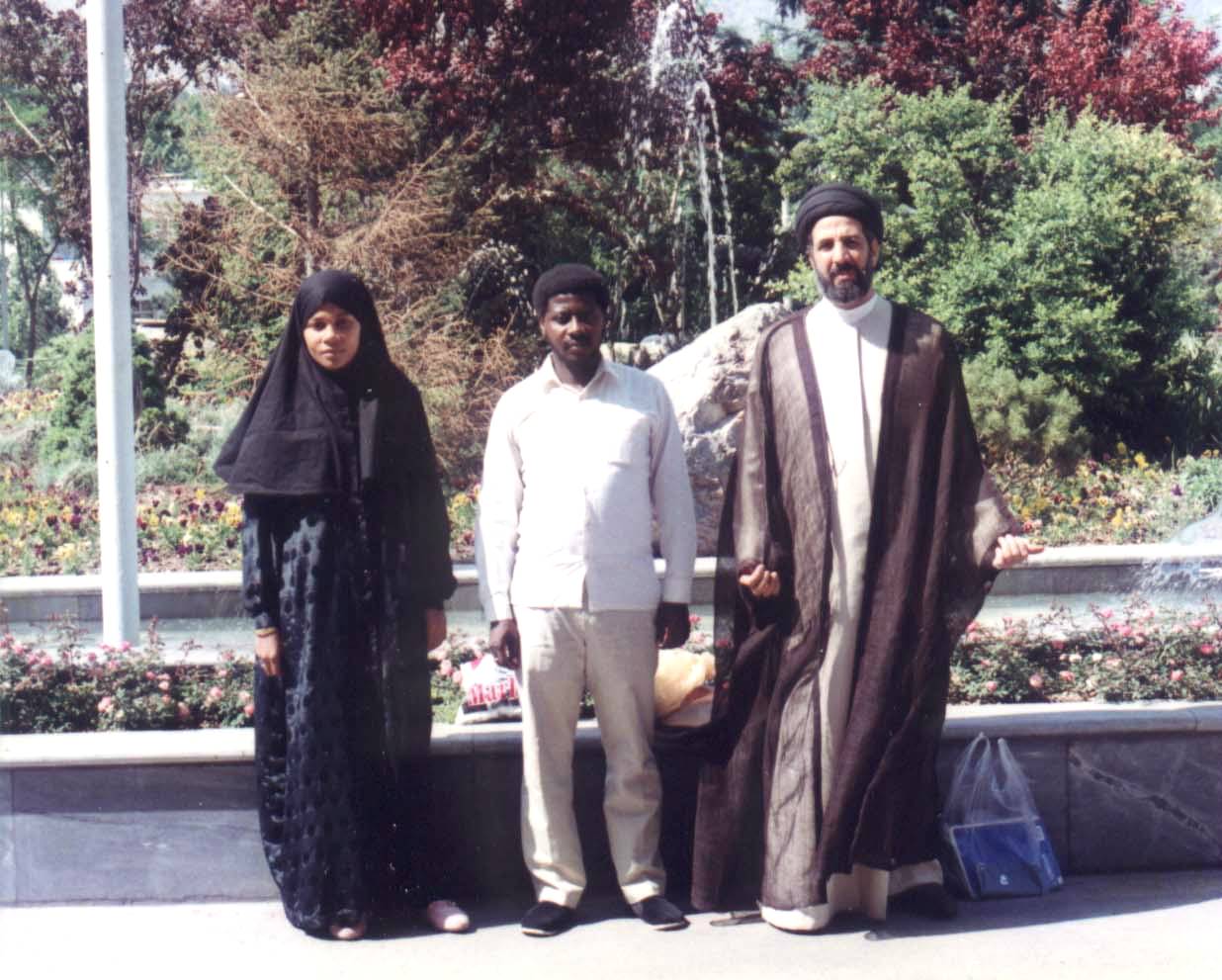
Thus began my first encounter with the presence of African peoples who inhabited an large portion of the Middle east from Southern Iran including Basra in Iraq to India, Pakistan and Baluchistan where there are literally hundreds of thousands of these truly invisible people. In Pakistan and Baluchistan they are referred to as “Makrani’s” due to the fact that the early slave ships plied their trade from Slave ports in East Africa to the eastern coast of the above mentioned countries which is depicted geographically as The Makran Coast.
Students of the African Diaspora might be rewarded if they turn their researchers eyes to this part of the world, which is rich in the African presence. There are many historical accounts of the “Zanji Revolts” in earlier Iraqi history, which took place around the time of the reign of the Caliph’s Mamoun and Harun al Rashid.
(2) During the commemoration of Imam Khomeini’s demise – Russia opened it’s borders to allow the Muslims in the various Autonomous Republics Turkestan, Arzibaijan, Uzbekistan, etc. to attend the ceremonies in Iran. As a matter of fact Gorbachev had come to the United States to visit with the President. The streets of Tehran and many other cities were overflowing with mourners, never have I seen that many people in one place at one time. An interesting fact: the major news media were there in full force, NBC, CBS, BBC, et-al – camera’s rolling continually wherever you looked. They were particularly visible at the Mosque/Shrine of Imam Khomeini and at the Friday Prayers at The University of Tehran. Yes it was interesting – On my return to the United States many of my friends called me to express their sadness that the Conference and the Commemoration Ceremonies were a failure. I immediately turned on the TV and was quite shocked to see what was presented as recent coverage – empty streets and an empty shrine, a few old people were placed here and there in the footage fingering their beads. The western media had reported quite the opposite to what I had witnessed first hand as perhaps the greatest Muslim presence ever, with the exception of the Pilgrimage to Mecca.
One day I will dig out the photographs that I took of that trip, particularly the ones I took from the helicopter that transported me over the streets of Tehran and into the desert area to the Tomb of Imam Khomeini. The awesome sight of Rivers of black robed mourners flowing throughout the length and breadth of Tehran converging at the burial site and spilling out forming concentric circles around the mosque complex, creating a veritable bulls eye in the barren desert.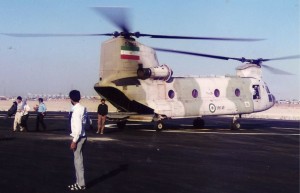
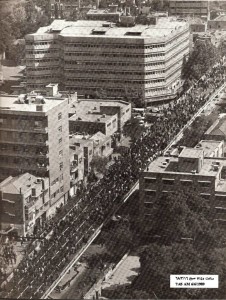
The last two images are from “Soroush Magazine,Tehran,1989”
Al Hamdullilah! The above last paragraph has finally been accomplished with the able assistance of my dear friend, student and adopted son Saleem McGroarty, of Edinburgh, Scotland , without his encouragement and technical assistance much of my work would not have found its way to the light of day – and for that I am eternally grateful.

